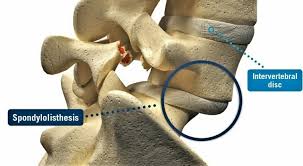What is
Spondylolisthesis
Spondylolisthesis occurs when there is abnormal alignment of the spine when seen from the side (lateral view). The vertebra above slides forward relative to the one below it. This misalignment may result from several causes, including trauma or degeneration. There may be abnormal spinal motion associated with this condition. Spondylolisthesis may result in back or neck pain, but extremities can be involved if the spinal cord or nerve roots are compressed or irritated. Commonly, patients will complain of muscle spasms, thigh and/or buttock pain, and/or tight hamstrings. There are patients who have spondylolisthesis and do not have symptoms. Spondylolisthesis can be congenital (present at birth) or develop in adolescence or adulthood. The disorder may result from the physical stresses to the spine from physical activity, trauma, and general wear and tear.

How do you Screen and Diagnose Spondylolisthesis?

The best initial test for diagnosis of spondylolisthesis is an X-ray taken in the standing position, with the spine flexed and then extended. For further confirmation of spondylolisthesis, a CT scan may be ordered. If the slipped vertebra is suspected to be pressing on nerves, the doctor may order a myelogram or an MRI scan. In addition to imaging studies, part of your visit to the doctor will include physical and neurological exams. In the physical exam, your doctor will observe your posture, range of motion and physical condition, noting any movement that causes you pain. During the neurological exam, your doctor will test your sensation, reflexes and muscle strength. Very commonly with spondylolisthesis, the neurological exam findings are relatively normal.
Treatment varies with severity of the spondylolisthesis. Most patients require only physical therapy combined with activity modification. If pain is arising from nerve root irritation, epidural steroid injection may be considered. For cases with severe pain not responding to therapy, if the slip is severe or there are neurologic changes, the slipping vertebra might be surgically fused to the vertebra below it. It is important to discuss treatment options with your doctor in deciding which treatment, if any, may be best for you.
What are the Treatments for Spondylolisthesis?

Request An APPOITMENT
Fell free to contact us with any questions or concern regarding Back/Neck pain.